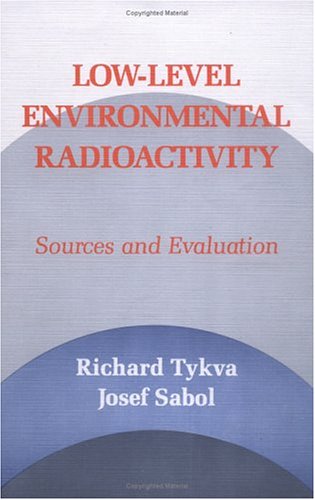From the Introduction
Low-level radioactivity is related to those radioactive sources of ionizing radiation that are characterized by low activities. Sometimes activity here does not represent total amount of radionuclides but rather their concentration. In other cases, the total activity may be quite high, but we can measure only a relatively small portion of the material. "Low" may have, for different situations and circumstances, not only considerably different meanings but also different absolute values as far as the activity or activity concentration is concerned. For example, one can refer to low activity in the case of radiocarbon dating, where the concentration of 14C is actually lower than its natural concentration, and also in the case of radon monitoring where, especially in mines or in some enclosed spaces, its concentration may be several thousand times higher than the outdoor "atural" concentrations.
Emphasis is now being placed on the analysis of naturally occurring radionuclides in the environment or on the release of radionuclides from their different man-made sources because liquid and aerial discharge level controls have become more rigorous. In addition, the applicability of low-level methodology increases the extent of different radionuclide applications considerably.
Since individual radionuclides differ in their decay scheme and particles emitted as well in their energies, there is no universal method for the accurate measurement of all radioactive sources. Moreover, there is usually a mixture of radionuclides in a sample, causing some difficulties in a selective evaluation of a given radionuclide. Due to the random nature of radioactive disintegrations, the appropriate interpretation of the experimental results would be, in most cases, impossible without elaborate statistical treatment and evaluation of the data obtained. Thanks to the availability of computer-based instrumentation, the measuring data can be, in most cases, processed and evaluated on-line, which makes it possible to control and optimize the experiment in order to extract the maximum amount of information carried by the detector response.
The purpose of this book is to provide an introduction to low-level radioactivity assessment and to clarify the nature of its sources, as well as the principal methods used in its measurement. Our evaluation is concentrated on the present-day aspects of low-level methodology. The book may be useful for all who need highly sensitive analysis of natural or artificial radioactivity both within and outside the nuclear field.
The attempt of this book is to summarize the sources of environmental radioactivity and their possible radiological impact in terms of resulting doses to the population, and to present a sound review of the measuring methods and techniques for the evaluation of low-level radioactivities encountered in both the environment and in a number of applications where radioactive sources are used as a means of obtaining important information.
- ISBN10 1566761891
- ISBN13 9781566761895
- Publish Date 13 April 1995
- Publish Status Out of Print
- Out of Print 3 December 2012
- Publish Country US
- Publisher Technomic Publishing Co ,U.S.
- Imprint Technomic Publishing Co
- Format Hardcover
- Pages 344
- Language English
